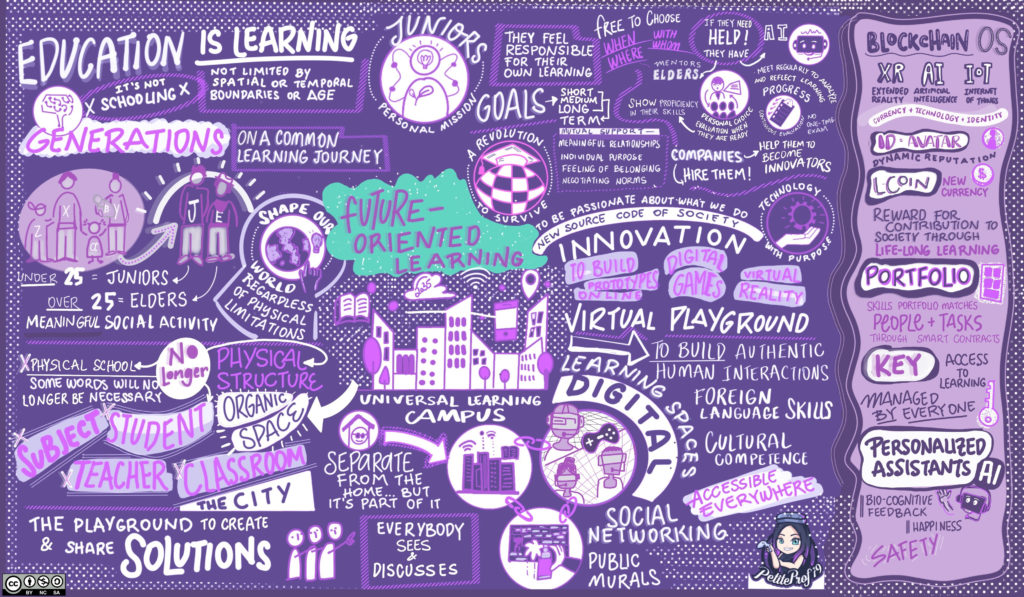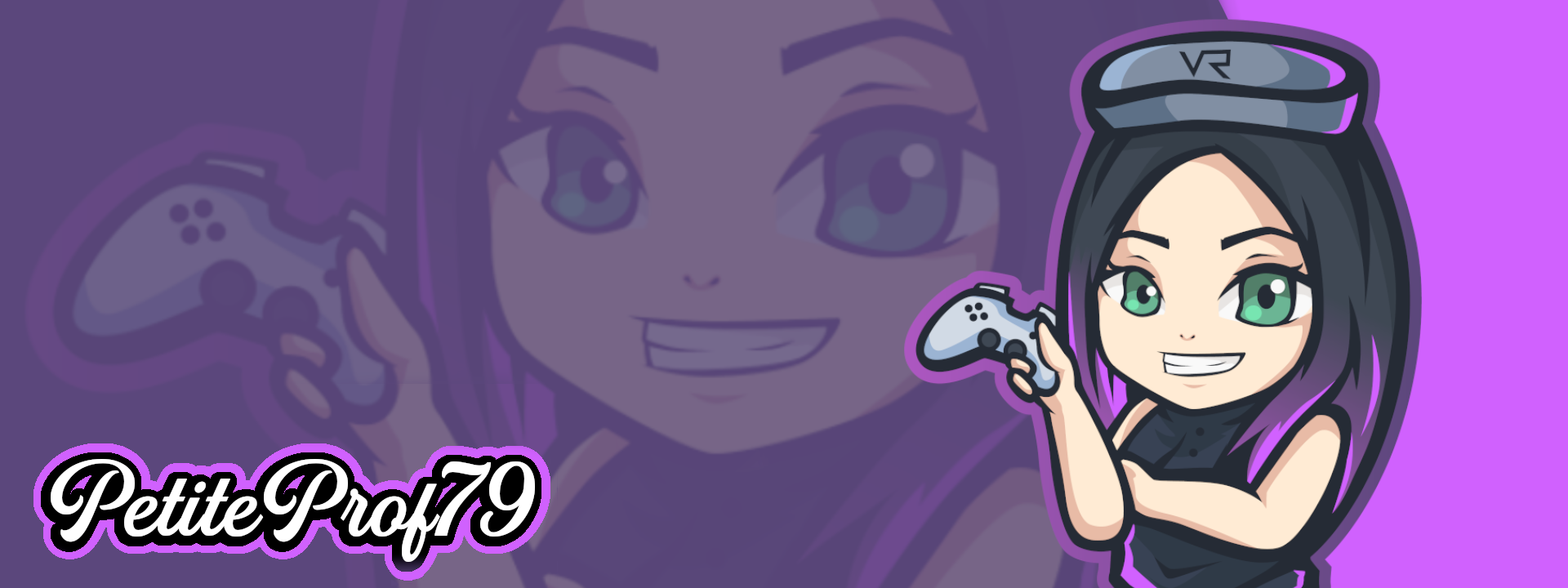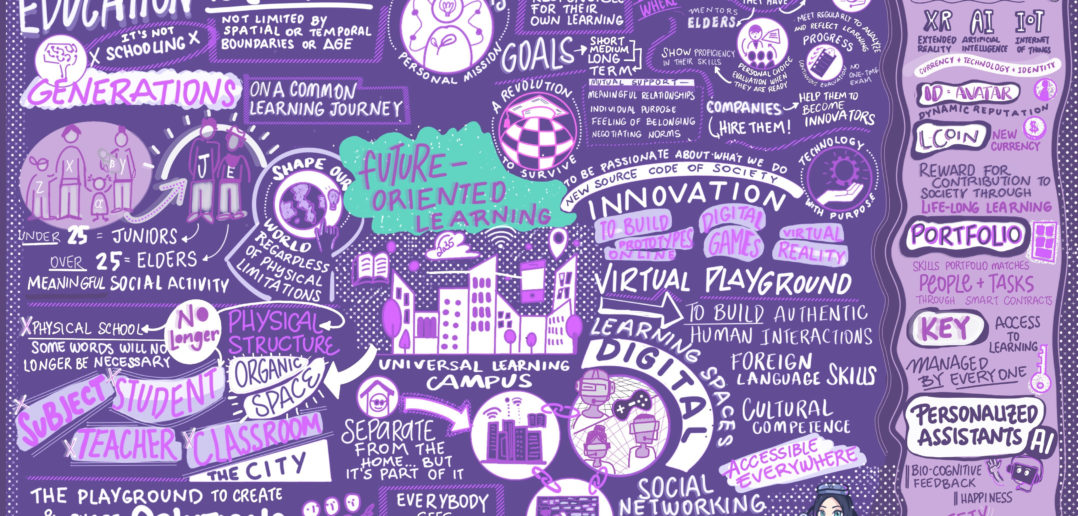In 2035, people have finally understood that we learn best when learning becomes a meaningful social activity that is relevant to everyone involved. Learning is not limited by physical or temporal boundaries, or age, for that matter. Every learner can be at the giving or receiving end of knowledge and skills. In other words, learning is defined by participation in a meaningful activity that is based on shared values and skills that are considered important. Those are among others the 6C: communication, collaboration / cooperation, creativity, critical thinking, character, and citizenship, with creativity being crucial to the whole process of participation.
 Credits: Stephanie Wössner | CC BY-NC-SA 4.0 International
Credits: Stephanie Wössner | CC BY-NC-SA 4.0 International
So, in 2035, education is no longer equal to schooling but to learning as a universal human quality. “Elders,” i.e. the Silent Generation, Baby Boomers, Generation X, Generation Y (a.k.a. Millennials) and Generation Z (a.k.a. Zoomers), and “juniors,” i.e. Generations Alpha and Beta, are partners in a universal strive towards happiness and peace. We have adapted to the idea that the world is organic and in a constant state of flux. After having turned their backs on the idea of schooling after the Covid-19 pandemic, educational leaders faced a difficult task: they needed to accommodate the status quo, i.e. several generations of children, parents and grand-parents who had been brought up in a schooling system dating back to the Industrial Age and based on ideas dating as far back as the Enlightenment. This meant that they had to hack their mindset by presenting options, thus creating learning opportunities people didn’t think they needed in order to show them their value. But the ultimate goal was that the role of the elders would change over time and become less crucial to the initial stages of this learning process, which has finally happened with the arrival of Generation Beta. The formerly common hierarchical structures of learning have finally come down with it.
We now live in a world, where everyone under 25 is a junior and everyone over 25 is an elder. The juniors shape their process of learning on an individual level for the greater good of the community, and so do the elders, who have become learners again, too. Europe and the rest of the world have moved closer together but without giving up their cultural identities. Every 7 years, the United Nations of Democracy declare a handful of sustainable development goals, i.e. current problems and needs that concern all of us (like climate change, health, human rights, gender equality, emerging technologies…). Based on these key objectives, learners can declare missions and be called upon to solve real problems with support from and for their community and in collaboration with people from all over the world. This is true for juniors and elders alike. While younger juniors are usually guided towards their first mission, older juniors declare their own missions and modify them in an iterative design thinking process with their peers and elders as partners and by practicing futures thinking.
This does not just require a vision, but an all-consuming passion to make the world a better place and has empowered people from all over the world. Over time, this has created a network in which certain elders and juniors hold a counseling position that helps manage the network and the connection between networks. Elders’ and juniors’ expertise are equally valuable as we move from juniors learning from the elders to juniors sharing their knowledge with the elders as partners in a common learning journey.
In terms of design, the learning space is no longer limited to a building or a campus, but every town and quarter of a city has become part of the universal learning campus. This physical learning space of the city is of course part of a network of learning spaces that everyone can travel to. If the destination is too far away or if whatever is to be done cannot be done in the physical world, there is the option of moving to the digital learning space. The digital learning space is an open virtual world called the IOWD (Immersive Open World of Democracy) and an extension of the physical space that is, among others, a place of social networking offering opportunities for authentic human interaction and a place where everyone can thrive in. This is also where foreign language skills and (inter)cultural competence are built. Moreover, it is a place that is actively shaped by everyone who lives there and that allows us to overcome boundaries. In other words, this is the world we can shape the way we want regardless of physical limitations.
However, this digital learning space is accessible everywhere, for it is linked to the physical world in many places. For example, some missions will make it possible to share solutions for problems in the physical space via open presentation spaces, in the form of murals, etc. for everyone to see, discuss and use. There is also always the option to make a digital clone of real-world objects if we want feedback from people beyond our physical world. Moreover, if this kind of physical presentation is not an option or has limits, there is a link to the digital world, where those working on the same mission or similar missions can build prototypes, new buildings, other objects they would not be able to build in the physical space. Furthermore, everyone else can not only look at them but use them as a basis for their own problem-solving work or contribute to them. This digital space is therefore a virtual playground accessible through different technological means, for example digital games or extended reality (augmented, mixed or virtual reality) devices that fit in our pockets or are embedded in our clothes and accessories. This has only been possible due to the quick adoption and development of new technologies under ethical conditions. It has also let to everyone having a digital alter ego that represents us in the digital world and that evolves with us. So technological inventions have had a ripple effect that culminated in continuous innovation shaping our world. We have even come as far as being able to connect the virtual world to the physical world in a way that we can easily customize certain aspects of it, for instance colors.
To make this universal learning campus, which is ultimately the world, a safe place, Blockchain has quickly developed at the intersection of currency, technology, and identity. The Blockchain, as it intersects with Extended Reality (XR), Artificial Intelligence (AI) and the Internet of Things (IoT) is the basis for a completely new operating system of a global society. Here are a few examples of what this has led to:
- Everyone has a unique avatar that is a representation of the self and that is at the same time our means of identifying ourselves in the digital world. So it has become normal that our IDs carry information on both our physical and our virtual identities.
- We all have personalized AI assistants who are by our side from early on and who have different means of helping us, for example bio-cognitive feedback through the Internet of Things and Extended Reality devices. They work with us and help us improve and be happy and can be just a voice only we can hear or a virtual person that we can summon and who can appear when they think it necessary. Even though only juniors get an AI assistant automatically, more and more elders have chosen to get one, too.
- The L-Coin is a new currency of life-long learning based on various forms of learning (for example micro-credentials and being a learning partner). It is how people are rewarded for their contribution to society through learning. They can trade L-Coins for other currencies, products, or services.
- All our skills are stored in digital portfolios and matched to available tasks by smart contracts. We are free to decline a task if it doesn’t fit our mission, but usually problems are broken down into smaller tasks that might help us accomplish our mission in the long run. This process makes sure that we are not faced with challenges we are under- or overqualified for and that lead to bore-out or burn-out, so we will always be in a state of flow. Our portfolios are linked to our IDs and provide us with a kind of dynamic reputation.
The key to all this is that learning is managed by everyone, not just a few, so it is accessible to everyone and it is not controlled by one single authority. It also ensures safety for everyone, including children who can move freely about, and that the physical structure of the learning space will remain organic. Moreover, over time, words like “classroom”, “teacher”, “student”, “subject” etc. have become obsolete because without a physical school they were no longer necessary or logical.
In terms of time management, our missions have become what we used to call “jobs”. At first, juniors were required to spend a certain amount of time learning but they were free to do so when and where and with whom they wanted as long as they worked on the missions they had declared for themselves at the appropriate age and that “grew” with them. Today, this requirement has become less important, as it has become part of their DNA (in a figurative sense). Their city is their playground as they live in a world, where learning happens in a culture that values experience, play, intrinsic motivation, flat hierarchies and that juniors and elders shape together. So there are for instance libraries, cafés, restaurants, parks, adventure and leisure spaces, arcades, but also co-working spaces, maker spaces, etc. that are free for everyone to use because all elders contribute to them through taxes. This also makes sure that the parents of these juniors do not have to worry about them because they know that they are safe. And since we have moved away from 9 to 5 working schedules anyways, it has become more and more common for extended families to work on related missions. However, if parents and children do not work together, parents will know their children are safe and they will be able to balance work and family life according to everyone’s schedules.
A part of this safety net and an element of guidance are the personal AI assistants that accompany juniors from early on and at least one appointed elder they meet with regularly alone and in small groups to reflect on their progress in relation to their short-, medium- and long-term goals and who they can turn to whenever they want. However, they also have access to other elders if they need them or they can seek help from mentors in their own age group. Once they feel ready to pass an evaluation, they will go seek it from a group of elders and juniors proficient in the (sub)skills concerned. So there is no one-time exam, but continuous evaluation as you go and the results become part of your personal skills portfolio. When a junior turns 25, their skills portfolio will be evaluated by a group of elders from different backgrounds who will then either invite them to join their missions as collaborators (= “hire” them), or who will give them opportunities to become innovators (= “founders”) in their own right, similar to the start-up culture of the beginning of the 21st century.
In summary, the world has become a learning space that is not separate from the home but is part of it. Innovation is no longer an attempt to update, upgrade or optimize the current system, but it represents a fundamental change in the source code of society that has challenged old assumptions about education and society. So, in other words, innovation has proved to be the reset button for education and society.
The challenges that stood between us and the future are no longer real challenges: technology has become our ally, we all have a purpose and are passionate about what we do and therefore, it no longer feels like an effort to invest energy. This world also allows for a variety of experiences in the physical world through interaction, people are free to participate in shaping the world in a way meaningful to them. They interact in both the physical and the digital spheres and have meaningful relationships, negotiate norms and their individual purpose. All this will give them a sense of accomplishment, of mutual support and a feeling of belonging in the world they help shape.
It is based on my personal theory of learning that covers both the distributed individual and the distributed collective spaces. The details are backed up by different signals from the future. So this is one of many potential stories of the future, intended to engage people to interact with it or spin off of it.
Let me know on social media (@petiteprof79 on Twitter) how this story from the future makes you feel on a scale from one (it’s terrible) to ten (very hopeful) and how to +1 your response (what would add 1 to the number you chose).
Bildquellen
- Learning in 2035: Stephanie Wössner | CC BY-NC-SA 4.0 International

